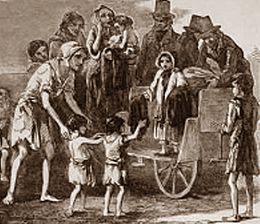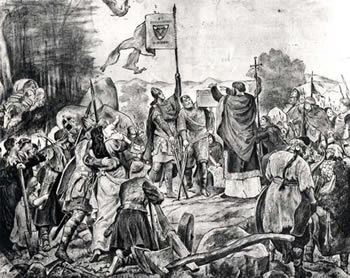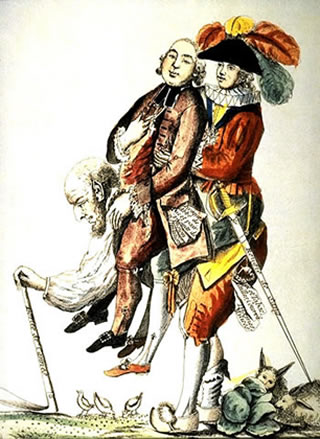You are in: Migration Museum > Migration Movements
Migration Movements1
(Part 4 of 4)
The reasons for leaving the homeland were varied:
- existential threat posed by wars or natural disasters,
- overpopulation,
- infertility of the soil,
- insufficient development of industry, trade and transportation,
- authoritarian order of many States,
- religious oppression,
- persecutions,
- difficulty in creating a satisfying existence in the homeland, and
- the prospect of better economic conditions in another country.

The historical development of a people has a great influence on emigration.
Thus, the Germanic people are characterized by a traditional migratory instinct. The Italian people also leave their homeland but to a lesser extent and the French are the most settled in their homeland.

Georg Bleibtreu, 1884:
The immigration of the Transylvanian Saxons
The German emigration to the east, i.e. to Russia, Hungary and Transylvania2, was inspired by the rulers of those countries to settle the unpopulated areas and their "semi-barbaric" subjects by using German culture to raise them to a higher level. The German emigration to the West, to North America, was originally prompted by political and religious oppression, war and famine.
It is easily understood that emigration was advantageous, to the host country, as the settlers brought military, fiscal, cultural and political security benefits.
The émigrés were generally young, strong people who arrived in the foreign country with some financial resources.

The farmers, the 3rd estate,
bear the burden of the other two estates
Emigration during the Middle Ages was often denied as a result of third party rights (serfdom). Later, efforts were made to ban emigration by prohibition laws3 and high taxes, i.e., to preserve the mother countries base of taxpayers. In many cases, "clandestine immigration", but in particular the recruitment and inducement to emigrate, was met with strict penalties including "bodily punishments and life sentences."
In contrast however, emigration within the Holy Roman Empire (also called internal colonization) presented no difficulties.
1 Thanks to S. Winkler for help with the English translation of this page
2 Transylvania = landscape, inside of the Carpathians curve which today belongs to Romania. From the 3rd century BC it was part of the Kingdom of Dacia, from 106 to 271 AD part of the Roman province of Dacia, since the 7th century of the First Bulgarian Empire, from the 9th/10th century to the 13th century of Hungary.
In the 10th century, to the border protection were settled Székelys (a subgroup of the Hungarian people), then from approximately 1150 German farmers and craftsmen (Transylvanian Saxons); from 1211 to 1225 the Teutonic knight extended in the Burzenland (historical border region in southeastern Transylvania). A Romanian population is attested certainly only since about 1210. In 1437 it came to the "Union of the three Nations" (Székely, Hungary, Saxony) to defence the advancing of Turks since 1432.
After 1493 until about 1530 the threat by the Turks led for to the reconstruction and development of the churches to fortified churches. After the battle of Mohács (1526) Transylvania came under Ottoman sovereignty; in 1688 or 1691 Transylvania fell temporarily under the Habsburgs (Austria) sovereignty, in 1699 (Treaty of Karlowitz) finally under the Habsburgs sovereignty, maintaining its autonomy; in 1848/49 briefly, shortly after the Austro-Hungarian compromise in 1867, reunited again with Hungary. The magyarization's politic encountered the resistance of the local Romanians and Saxons. By the Treaty of Trianon (1920) Transylvania returned to Romania, by the Second Vienna Award in 1940, Northern Transylvania and the Székely Land (Eastern Transylvania) came to Hungary and in 1947 by the Treaty of Paris all Transylvania came to Romania.
3 The domestic departure right in the Prussian States was lifted by the Decree of 27 November 1777, but reintroduced by the Edict of November 1787 (Article 176).
In the Kingdom of Württemberg, it was lifted in 1807 but restored on 15 March 1815 by the Constitution of the Estates (Article 56).
Moreover, the Constitution of the German Confederation of 1815 (Article 18) allowed the emigration of the subjects of the German princes and the inhabitants of free cities to move, if another state accepted them as subjects.
In Württemberg, the emigration right was lifted completely by the law of 19 November 1833.


